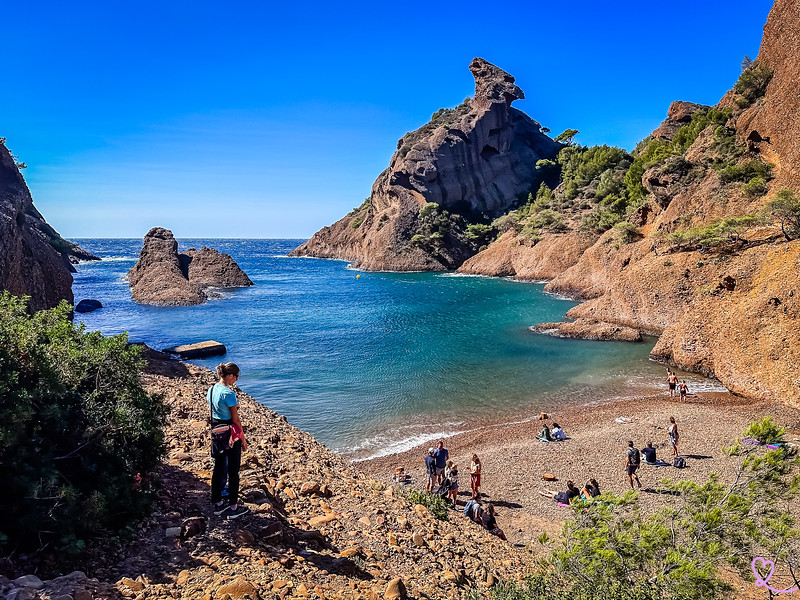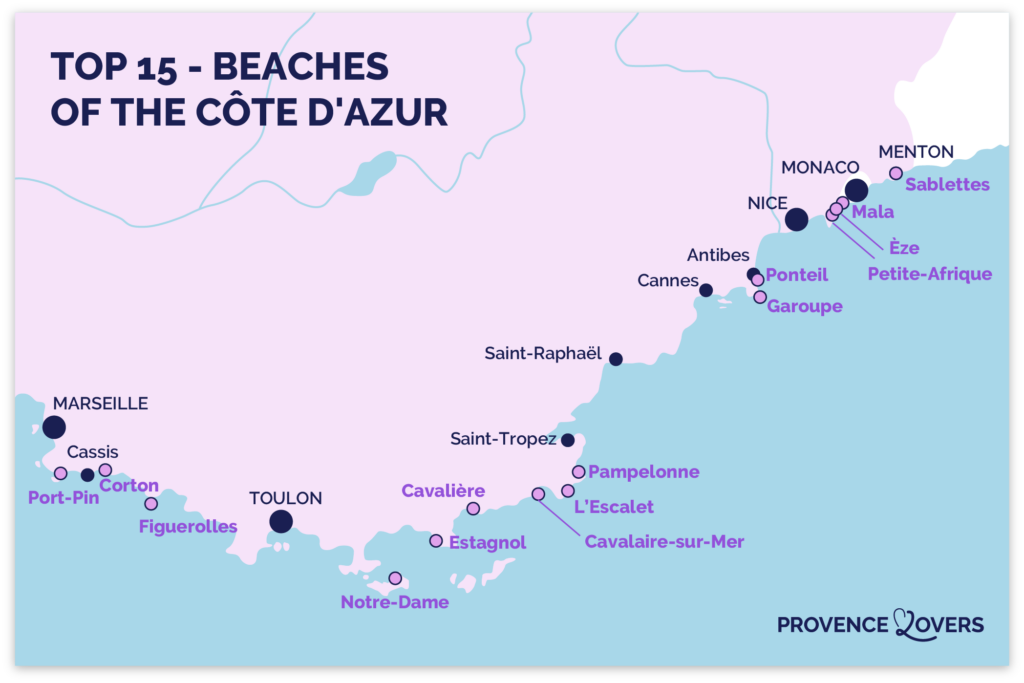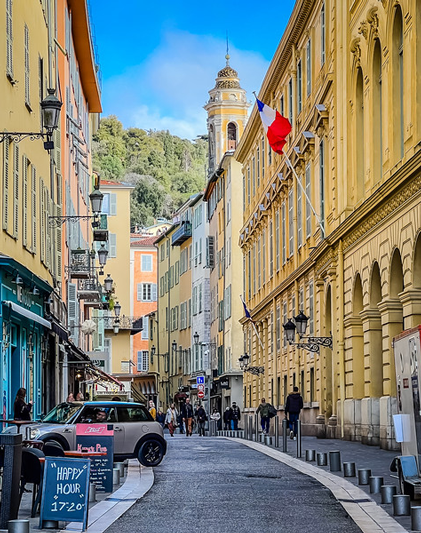What a surprise! Barely out of a housing estate, you enter a path and discover a splendid landscape of ochre rock, caves and turquoise water. The location is truly exceptional.
Here are our tips for visiting the Calanque de Figuerolles at La Ciotat and enjoying all it has to offer!

This guide is completely independent, based on our experiences. We visited the region anonymously, making our own choices and paying our bills in full.
Why visit the Calanque de Figuerolles?
Yes, this cove is well worth a visit.
It’s one of the most beautiful in the region, with its orange rock contrasting with the turquoise waters. What’s more, it’s within easy walking distance of the city!
It’s one of the most beautiful beaches on the Côte d’Azur.

In our opinion, the 3 reasons to visit this beach are:
- The scenic beauty of this cove formed by erosion over millions of years. The colors are exceptional, as are the shapes of the rocks. It has been painted by artists such as Georges Braque.
- The location of the calanque, far from the more popular Cassis and Marseille coves, yet within easy walking distance. It’s not often that you can see scenery like this with just a 20-minute walk from the old port!
- The geological interest of the area to get a closer look at the ochre-colored Poundingue rock.
Its name means Fig Tree Garden in Provençal. In our opinion, this is the most beautiful beach on La Ciotat (see our list).
Access and map – Calanque de Figuerolles at La Ciotat
Where is the Calanque de Figuerolles?
- In the town of La Ciotat, between Marseille and Toulon.
- South of downtown
- In the Calanques National Park
- From Marseille: 1h drive
- From Cassis: 30 min
- From Toulon: 25 min
- Here’s our map of the Côte d’Azur’s most beautiful beaches, including Figuerolle to the west:

How to get there – access road
You have several options for accessing the calanque parking lot:
- Get there by car. These are city streets, easy to navigate with plenty of signs. 5min from the old port
- On foot from the old port: 20-30 min walk, with a slight uphill slope
- Bus line 30 brings you closer to the parking lot
For the more adventurous, you can also discover it by kayak, as well as Cap Canaille and Île-Verte. See program and availability.

OUR TPS FOR RENTING YOUR CAR IN Provence
- Compare prices on our preferred platform: DiscoverCars – one of the best rated sites.
- Choose a car that is powerful enough (the roads are steep) but compact (some passages are narrow).
- Think of thecomplete insurance (some roads are tortuous and narrow).
- There is a lot of demand, book it early.

Parking de la Calanque de Figuerolles
Near the calanque, there’s a small parking lot on Avenue des Falaises. It’s not very big and fills up pretty quickly. This parking lot is subject to a charge.
There are also paid parking spaces in the surrounding streets.

Access to the beach from the parking lot
It’s a 5-minute walk from the parking lot.
The trail is clearly marked.
There are several staircases to descend to reach the most beautiful views and then the beach.

WHERE TO STAY IN La Ciotat
Option 1: Old port side
Enjoy the charm of the old town, the port and all the restaurants.
We recommend..:
- Best Western Vieux-Port Hotel with rooftop pool – see prices, photos and availability

Option 2: Beach side
With sea views and direct access to beaches. We recommend..:
- Aparthotel A Deux Pas de L’Eau – see prices, photos and availability
- Hotel Rose Thé – prices, pictures and availability

On the sand and in the water…practical advice
Best time to visit
The beach is quite popular, but still more secluded than many Côte d’Azur beaches.
In summer, be sure to come early to enjoy some space and peace and quiet.
Outside summer, you should have no trouble finding space all day long on weekdays.

The cove faces southwest and is quite deep, so you won’t see the sunset. However, the hours of sunrise and sunset make the colors even more beautiful when the low-angled sun hits the ochre rock.
Beach type and size
It’s a beach of small colored pebbles. Colors range from pink to red and from yellow to orange.
Visually, we think it’s superb. But if you swim, we recommend you take swimming shoes.
The back beach is a mix of pebbles and earth, so be sure to add some color to your towels!

Conditions for swimming
The slope is quite steep, so it’s not ideal for young children.
However, it’s a superb place for swimming and snorkeling.
Facilities and activities
Monitoring
The beach is not supervised.
Showers, toilets, deckchairs…
There are no facilities on the beach apart from the restaurant and snack bar. No public toilets, no showers.

Shadow
There aren’t really any trees to protect you in the middle of the day.
Nautical activities
No equipment rental on site, but you can visit the calanque by kayak (as well as Cap Canaille and Île-Verte) – See program and availability.
Catering
Along the descent to the beach, you can find..:
- a snack bar for fast food
- Restaurant Calanque de Figuerolles also known as Restaurant Chez Tania – arrive early or make a reservation as it’s quite popular. Open for lunch and dinner. Unfortunately, the tables don’t have the magnificent view of the calanque…
The restaurant also has a small hotel. Ideal for those looking for peace and quiet and the chance to immerse themselves in nature – see prices, photos and availability

A LITTLE MORE patience
All the photos, maps, information, good addresses to make your stay in Provence a success, will soon be gathered in a single ebook!
If you wish to be informed of the publication of our guide on Provence, subscribe:

Information for children, mobility, dogs, naturism…
- Calanque de Figuerolles with children
It’s not an ideal beach for young children, but older ones will enjoy exploring the cliffs and caves. - Calanque de Figuerolles with a dog
Dogs are allowed but must be kept on a leash. - The Calanque de Figuerolles in reduced mobility
The calanque is not accessible to people with reduced mobility. - The Calanque de Figuerolles and naturism
This is not a naturist beach.

What to see on and around the beach
Pudding
The calanque’s cliffs are made of ochre-colored rock. This is pudding, a sedimentary rock, a conglomerate made up of debris. The ancient pebbles were transported over a long distance by an ancient coastal river.
The larger the pebble, the greater the speed of the water current that deposited it.
Some species have adapted to these rocks and even blend in with the scenery, like the little gecko: Hemidactylus Verrucatus. You won’t see him during the day, but he goes out hunting at night.

Dwarf palms and vegetation
All around the cove, you can still see some vegetation.
These include dwarf palms. It’s the only species of palm in Europe; it’s very hardy because it loves sea spray, drought and the local climate.

Capuchin rock (or dog’s head or eagle’s beak)
And of course, your eye will be drawn to the huge rock at the side of the calanque. It has different names, because depending on the angle from which you look at it, you can imagine different shapes.
Our photo below shows an eagle. What about you?
And if you look closely you’ll also see the silhouettes of climbers, as the area is a great playground for climbing enthusiasts!

A tale of pirates and plantations
Today, the place is generally very peaceful.
But historically, given its protected appearance, it was a pirate lair. That’s why a lookout was installed in 1543.
PLAN YOUR STAY IN La Ciotat
- Things to do in La Ciotat
- Best hotels to stay in La Ciotat
- Best restaurants (coming soon)
- La Ciotat’s most beautiful beaches
- Tour de l’Île-Verte (coming soon)
- Calanques de Figuerolles


